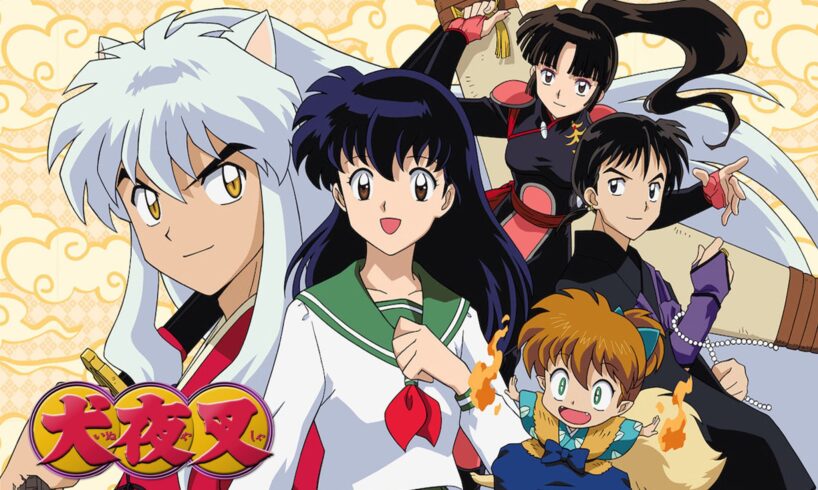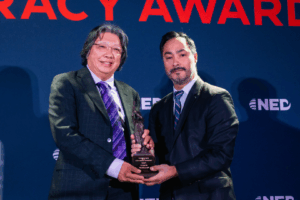
I still vividly remember the first time I accidentally stumbled into InuYasha. I couldn’t have been more than seven years old. I couldn’t sleep so I snuck out into the living room to watch TV. Unbeknownst to me, Cartoon Network had transitioned to its after-hours programming. With the quiet glow of the screen, I saw him for the first time.
The image of the sword-swinging dog-eared boy with the silver locks embedded into my subconscious and was reawakened when I picked up a copy of the manga some years later — my introduction to the medium. This led to me reading all 56 volumes of the original manga and watching all 193 episodes of the anime series, all before I left elementary school. I successfully convinced all of my friends to join in on my obsession and I proudly served as one of the cultivators of anime and Japanese pop culture in my small hometown where the Asian population was less than five percent.
InuYasha, to many fans around the world, was the gateway into the world of anime. It transcended language barriers and cultures, and remains a cult classic that is regarded as one of the pillars of anime evolution. Now as the InuYasha anime celebrates its 25th anniversary, let’s dive into a retrospective analysis of the history and legacy of this iconic series.
© Sunrise Studio/Bandai Namco Filmworks Inc / Shogakukan / Rumiko Takahashi, image courtesy of Netflix Media Center
Exporting Anime to a Global Audience
The InuYasha manga was Rumiko Takahashi’s fourth major work following Urusei Yatsura, Maison Ikkoku and Ranma ½. It began its serialization in 1996 through Weekly Shonen Sunday magazine and set the tone for a more mature, dark and action-packed tale compared to her previous titles.
With Takahashi’s already impressive track record for producing popular stories early into her career, publishers were eager to export InuYasha to the international market.
Viz Media was founded by Seiji Horibuchi, a Japanese businessman from Tokushima Prefecture who came to San Francisco with the idea of exporting Japanese pop culture overseas. It acquired the distribution rights for Takahashi’s InuYasha and began publishing paperback versions in North America beginning in 1998. The manga won the prestigious Shogakukan Manga Award for best shonen (comics primarily targeted at adolescent boys) in 2002 and sold over 50 million copies worldwide.
© Sunrise Studio/Bandai Namco Filmworks Inc / Shogakukan / Rumiko Takahashi, image courtesy of Netflix Media Center
The anime adaptation began production by Sunrise Studio (now known as Bandai Namco Filmworks) and broadcast the initial 167 episodes on Yomiuri TV and Nippon TV from 2000 to 2004. The series caught the eye of Cartoon Network’s adult-oriented programming block Adult Swim, bringing the English-dubbed series to a mainstream television channel. Viz Media also expanded their distribution into the European and South American markets, further amplifying InuYasha’s reach with additional translations.
Like other anime giants of the 90s and early 2000s like Dragonball Z, Sailor Moon, Pokemon and Naruto, InuYasha pushed the international anime boom of the new millennium and introduced a whole new generation to the animation fandom on a global scale.
A depiction of Inugami. Original image from the Hyakukai Zukan illustrated scroll of 100 yokai (1737) / Wikimedia Commons
Inspired by Japanese History and Folklore
InuYasha lives inside a robust storytelling world that is supported by exciting battle sequences, a goosebump-inducing score and deeply detailed lore strengthened through actual Japanese history and folklore.
Modern-day junior high school student Kagome Higurashi is sent back to the Sengoku era (roughly 1467 to 1600), also known as the Warring States period. The original Japanese title of the anime, Sengoku Otogizoshi InuYasha (InuYasha: A Sengoku-era Fairytale), specifically highlights the series as a fantasy period piece. The Sengoku era sat at the heart of the “feudal era,” which saw the political upheaval and social transformation of Japan as the Ashikaga shogunate’s weakening power led to the rise of independent daimyo, or feudal lords, who fought for supremacy. Thus, our “feudal fairy tale” has its setting.
InuYasha is often translated as a dog half-demon, but Japanese yokai are a bit different from Christian demons. They are not always evil; and range from being protectors to vindictive monsters. “Yokai” is the broad term for supernatural beings and includes ghosts, shapeshifters, spirits and other mysterious phenomena. Yokai have roots in both Shinto religion and Taoist philosophy. The lore behind InuYasha, his half brother Sesshomaru and their father Inu no Taisho in particular stems from the Inugami yokai mythology.
Other characters inspired by supernatural folklore include Koga’s ookami yokai wolf tribe, Shippo’s kitsune fox power and Hachiemon’s tanuki raccoon dog abilities.
Yutaka Kyan as InuYasha in the 2017 InuYasha stage play © Sunrise Studio/Bandai Namco Filmworks Inc / Shogakukan / Rumiko Takahashi ©2017 Nelke Planning, Euclid Agency, Shokugan
Celebrating 25 Years
While InuYasha’s popularity has dwindled as a new generation of anime takes the spotlight, the series remains a renowned classic that pushed for innovation. The series is now widely available on streaming platforms in multiple territories and languages.
Along with four films, InuYasha has been adapted into several video games, card games and even stage plays. In 2017, InuYasha was made into a stage production by Tennozu Galaxy Theater featuring Yutaka Kyan from the visual kei rock band Golden Bomber as the titular InuYasha, and Yumi Wakatsuki from idol group Nogizaka46 as Kagome.
InuYasha received a major update in 2020 with the arrival of Yashahime: Princess Half-Demon, a sequel that follows the daughters of both InuYasha and Sesshomaru. Yashahime was an original story that continued the InuYasha legacy. Katsuyuki Sumisawa developed the story as the series’ writer and presented it to Takahashi. With her blessing as storyboard supervisor, Yashahime brought back many of the original staff and cast — including Kappei Yamaguchi, the original voice actor of InuYasha. The English dub cast also reprised their roles, with Richard Ian Cox returning as the voice of InuYasha. The sequel series ran for 48 episodes, concluding in 2022.
Key visuals for the InuYasha 30th anniversary pop-up in Shanghai
Shanghai hosted various events this year to celebrate the series’ total 30-year anniversary, with a pop-up shop and a philharmonic symphony concert featuring the show’s musical composer Kaoru Wada.
There haven’t been any announcements on domestic celebrations for InuYasha so far, but the anime is a testament to the rich artistry and dedication that the medium influences as it continues to inspire new generations.
Related Posts
Discover Tokyo, Every Week
Get the city’s best stories, under-the-radar spots and exclusive invites delivered straight to your inbox.





